When the dates and cities were first announced for the South Indian Tour, I was silently thrilled. The tour included two cities I had hoped to visit – Rameshwaram and Kanyakumari. It also included Nagapattanam – the epicenter of Amma’s tsunami relief efforts – where almost 2000 homes have been built. Amma had been here twice before – less than two months after the tsunami struck, and again about a year later – for a public programme. In the first visit, I saw first-hand, the devastation that struck a small fishing village. During the second visit, I went to see a village of 340 homes that had just been completed, but not yet occupied. I was eager to return to see how things have changed since then…..
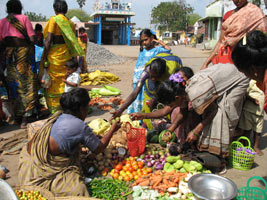 Chinnapillai sat in the road selling vegetables and berries in the shadow of a Krishna Temple. It was here that two years ago, less than two months after the devastating tsunami , Amma first visited Chinnapillai’s village of Kheel Pattinacherry in Nagapattanam, Tamil Nadu. Amma had sat inside the Temple, while hundreds of villagers gathered to receive her darshan and consolation.
Chinnapillai sat in the road selling vegetables and berries in the shadow of a Krishna Temple. It was here that two years ago, less than two months after the devastating tsunami , Amma first visited Chinnapillai’s village of Kheel Pattinacherry in Nagapattanam, Tamil Nadu. Amma had sat inside the Temple, while hundreds of villagers gathered to receive her darshan and consolation.
I remember being here then, walking towards the beach while Amma was giving darshan – seeing first-hand the immense devastation that struck the homes closest to the ocean. Today, I was walking these streets again, this time with four Brahamacharinis and two young men who were telling the villagers about Amma’s visit and handing out copies of her photo.
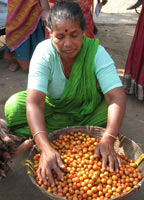 When Chinnapullai was given a photo, she immediately grabbed it and smothered it with kisses. “How can I forget Amma? She is the one who gave us food.” When asked if she herself was affected by the tsunami, she was quick to answer, “I cannot lie, my home was spared, I lost no relatives and I am safe. I was sitting here just as I am now, and when people started running from the ocean. I only then realized what had happened. I then started to give out the food I was selling for free. “ She gave us each a handful of berries in a gesture of gratitude. I ate a few – they were like small peaches. Not yet ripe, a little bitter.
When Chinnapullai was given a photo, she immediately grabbed it and smothered it with kisses. “How can I forget Amma? She is the one who gave us food.” When asked if she herself was affected by the tsunami, she was quick to answer, “I cannot lie, my home was spared, I lost no relatives and I am safe. I was sitting here just as I am now, and when people started running from the ocean. I only then realized what had happened. I then started to give out the food I was selling for free. “ She gave us each a handful of berries in a gesture of gratitude. I ate a few – they were like small peaches. Not yet ripe, a little bitter.
We continued further into the village. I wasn’t sure what to expect. I thought perhaps that the village would have been abandoned – with everyone moved to the new homes. But there was life all around. Children playing, women bartering over produce, animals in the streets. Indeed the tsunami had struck here, and those who had lost their homes had already been relocated or were still waiting for the government to grant their request. But some homes were spared mostly due to the lay of the land – and life continued for these folks.
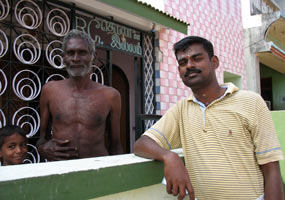
I was accompanied by Mohan who has been assisting with Amma’s tsunami relief efforts for the past two years. He came from Coimbatore less than a week after the tsunami struck and decided to remain and help. All the villagers know him. As we walked the streets, young children affectionately called him ‘Palkaran’ (milkman) – as his first task was to distribute milk to all the villagers.
We stopped at Ramayan’s house. He’s 65 years old, but looked more like he was 80 – his face weathered by the ocean. When food was being distributed in the days after the tsunami, Mohan would bring some to his home. He was grateful for Amma’s efforts – there were photos of Amma in his home. He told of how the tsunami had knocked down the four foot high cement barrier in front of his house. Water had risen more than 6-feet on his street, but the main structure survived. He is hoping for a new home if the government will give him one, as are many of the remaining villagers. When asked if life has been returning to normal, Ramayan’s daughter Elachi was quick to note that occasionally, rumors fly that another tsunami will strike. The fear is still there for these people who live perhaps only ½ km from the sea.
Mohan and I crossed paths with Devi, an 18 year old girl, who was now enrolled in college studying for her BC in Computer programming. She was one of the students who received tutoring provided by the Ashram to tsunami victims. Her family’s home and boat were both damaged by the tsunami. “I have great affection for Amma,” said Devi. The tutoring classes helped me prepare for my studies in college.”
 We continued our walk. Down to the beach where about two dozen tsunami boats were lined up on the sand. Many bore the yellow and red markings of boats repaired by the Ashram. They weren’t being used today. Not a single fisherman in site. The villagers were taking a four day holiday because Amma was coming. I was told that many of the women were at the programme site chopping vegetables. A group of children were standing in one of the boats – future fisherfolk. But instead of casting nets, they were trying to fly makeshift kites in the soft breeze that blew in from the ocean. I watched. Such simplicity and innocence in the midst of chaos.
We continued our walk. Down to the beach where about two dozen tsunami boats were lined up on the sand. Many bore the yellow and red markings of boats repaired by the Ashram. They weren’t being used today. Not a single fisherman in site. The villagers were taking a four day holiday because Amma was coming. I was told that many of the women were at the programme site chopping vegetables. A group of children were standing in one of the boats – future fisherfolk. But instead of casting nets, they were trying to fly makeshift kites in the soft breeze that blew in from the ocean. I watched. Such simplicity and innocence in the midst of chaos.
Mohan and I walked back into the streets of the village. We came upon Muragan’s home where a red boat engine sat in front. Muragan is the expert engine repair man for the village. He and two other village repairmen were employed by the Ashram during the months after the tsunami struck to help repair over 200 engines that had been damaged. The Ashram provided workshop space and labor fees .
We wrapped up our walk in front of the temple where we started. The Brahmacharinis recalled Amma’s visit. We passed out more photos of Amma. The children all posed holding up their new pictures of Amma. Tomorrow night they will be seeing her again – this time in person.
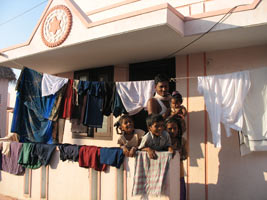 The first time I visited Samantapettai, the streets were filled with villagers seeking out their newly assigned homes. The homes were still unoccupied, the streets unused. One year later, I came back to see how it had changed. I was alone – I didn’t have a translator this time so I couldn’t ask questions. I only wanted to look around – to observe and see how one year had transformed the villager’s lives.
The first time I visited Samantapettai, the streets were filled with villagers seeking out their newly assigned homes. The homes were still unoccupied, the streets unused. One year later, I came back to see how it had changed. I was alone – I didn’t have a translator this time so I couldn’t ask questions. I only wanted to look around – to observe and see how one year had transformed the villager’s lives.
I found life everywhere. I first encountered a group of women gathered around a water distribution tank. We exchanged smiles. Children played all around. A small boy had a plastic bag tied to a string. He was trying to make it fly like a kite. Goats, chickens were everywhere. Two goats were on the stairs to the roof of one of the houses – one at the top, the other at the bottom – challenging each other in a stare-down. An occasional photo of Amma in the front entrance of some homes. I came across a group of children who were delighted to have their photo taken. A few dozen gathered around and kept posing, insisting that I take their photo. A camera and children – a great way to overcome language barriers…
There was a huge sign with Amma’s picture in the field just inside the entrance to the village. The children insisted that I take a photo of them standing in front of it. They ran to the sign, some held their hands in prayer, others waived – and I clicked.
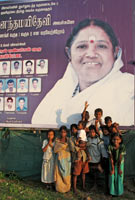 These were poor villagers. Amma has provided them with four walls and a roof from which to build a new life. Some may have received her warm embrace. Who knows where they would be today if Amma hadn’t showered her compassion on the people of Nagapattanam….. Amma will always be a part of their lives.
These were poor villagers. Amma has provided them with four walls and a roof from which to build a new life. Some may have received her warm embrace. Who knows where they would be today if Amma hadn’t showered her compassion on the people of Nagapattanam….. Amma will always be a part of their lives.
Sri Pati, USA
30 Jan 2007, Nagapattanam
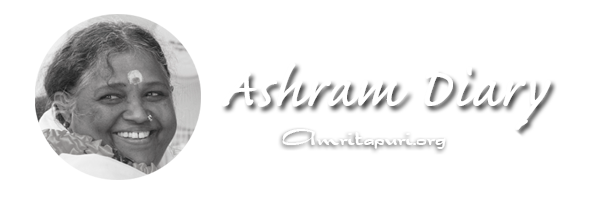

Leave a Reply
You must be logged in to post a comment.